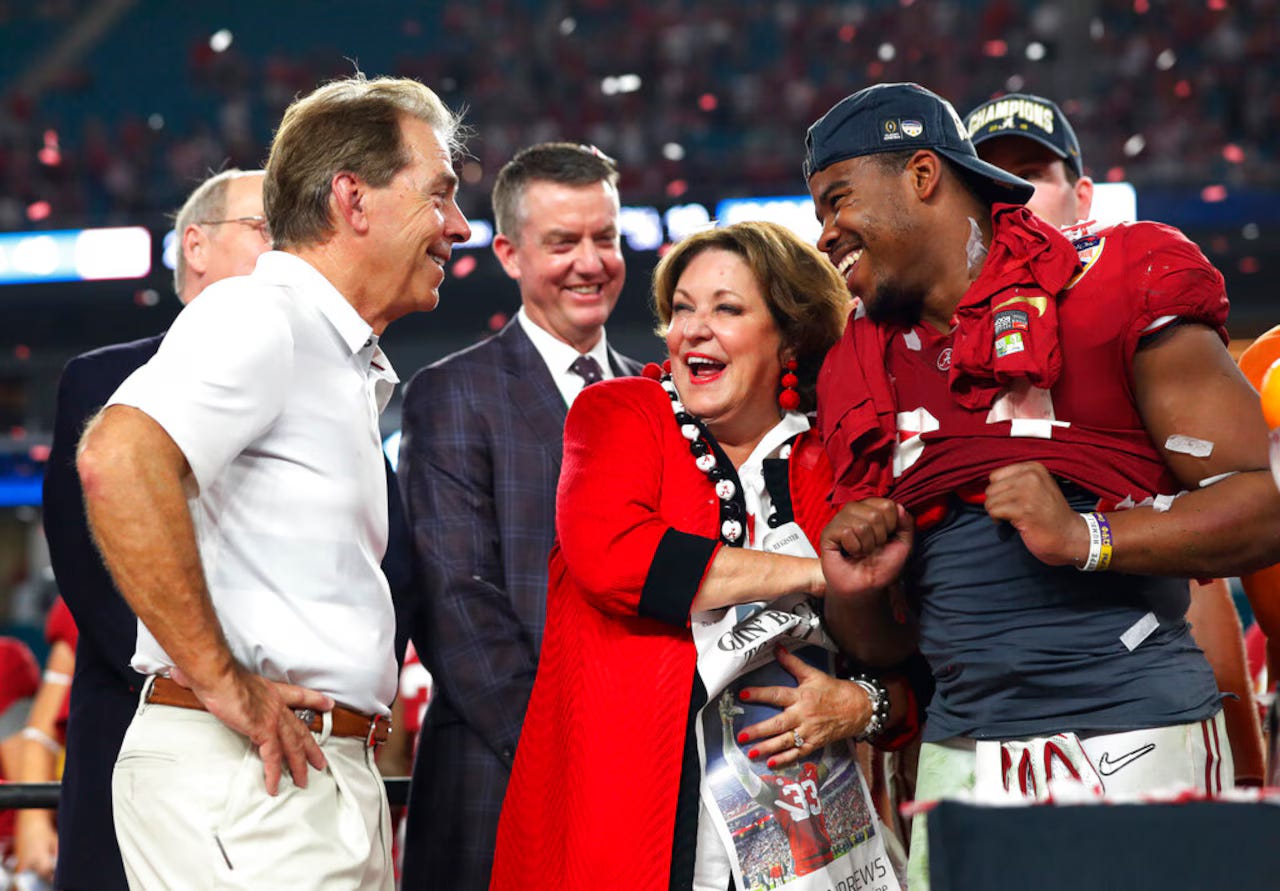Accountability Means More Than the Mistake: Positively Build It into Your Team
The most memorable lesson a man most remembers his Hall of Fame leader in college teaching him

While not all leaders react similarly, there are those who will be patient and tolerate some mistakes, especially when ownership of them is promptly accepted.
Damien Harris, a former player for Nick Saban, the legendary Hall of Fame coach who won a record seven national championships, tells one a favorite story of a lesson Saban deeply instilled in him.
"I want you to understand this (consequence) isn't because you were late, it isn't because you made a mistake, it's because you didn't come and talk to me about it, because you didn't take ownership of your mistake, because you didn't have the 'self accountability' to come look me in the face and tell me (what you did wrong),” Saban told Harris years ago.
“I felt (especially with you as a leader) that was a lack of accountability and because of that, I feel like you should be punished, not because you made a mistake,” Saban concluded to Harris.
It was a lesson that Harris values learning to this day.
Leaders, of course, commit errors as well that displease the people alongside and underneath them and those errors get compounded when a lack of honesty, accountability and sincere apology are not clearly, promptly expressed.
There are important things to know about why accountability is critical, how it becomes the norm, the collectively practiced one and how it benefits the mission.
“In leadership, accountability isn't just about admitting that you made a mistake, it's about establishing a standard of care for the team,” says Mircea Dima, founder, CEO and chief technology officer at AlgoCademy, an AI-driven coding education platform.
“A sense of accountability enhances trust, transparency and respect within the organization. It is important because it sends the message that making mistakes is a way of life.”
Dima talks about what he puts upon himself.
“Part of my role as a leader is to show that learning from your mistakes is much more valuable than concealing them,” he says. “Accountability holds more credibility and eventually reinforces organizational culture, so others begin to think like that as well.”
“Leader accountability,” says Steve Morris, “is the crucible in which team identity is melted.”
Morris, the founder and CEO at NEWMEDIA.COM, which creates websites and intranet portals for brands, adds that “when a leader owns a mistake, face to face with no deflection, it emotionally primes colleagues with the message: success is team-based, which means learning is too.”
He’s noticed something important and valuable from his own experiences, with disappointing and painful campaign launches and “product disasters” with which he’s been involved.
“When I step up and name my own errors, it somehow makes the compliance word ‘accountability’ an emotionally-vectorized concept,” Morris says.
“When team members see leaders model vulnerability, it unlocks new possibilities; the team starts feeling more pride and that increase in pride makes team members over-perform on the next campaign, which is exactly what happened with my team after one particularly disastrous product launch. The next quarter we blew our unique visitors record away.”
“Accountability is important for a few reasons,” begins Diane Dye, EdD, an organizational change and leadership specialist in business resilience and the CEO at People Risk Consulting.
“One is the ripple effect of a mistake. Sourcing where an error came from helps leaders track down whether the problem is personal, procedural or systemic.
“Second, accountable culture can train better. If you don’t know where an error came from, you can’t close knowledge gaps to improve.
“Third, it’s an integrity issue. It takes a good deal of bravery to be accountable and high performing teams are brave teams. These teams help when an organization must be resilient.”
People within organizations can assist in teaching each other the duty and discipline, regardless of emotions, to show accountability for errors.
”Leaders can create a culture of accountability by demonstrating what it looks like,” Dima says. “When leaders are prepared to take responsibility for what they do, it sets the tone throughout the organization.”
He explains how this can be easier to accomplish.
“Ensuring open communication and creating clear and consistent channels for feedback is crucial,” Dima asserts. “A key part of this is to make it safe to name mistakes, for people to speak up when things are wrong without fear of being punished or belittled.
“As a leader I inspire this by looking at how I can help rather than to blame and, as a result, others will reflect and learn to do this too, for themselves.”

Dye agrees about baking in safety to the team as a foundational piece.
“Leaders must make it safe to be accountable,” she advises. “This means taking a learning approach to failure.’
Dye elaborates:
“The first step to this is to emotionally regulate. Separate fear, anger and counterproductive emotions from the failure.
“Next is curiosity. Lean in with open, non judgmental questions about the failure.”
She shares a bit of her academic research and what important finding it revealed.
“In my dissertation, I looked at women who were struggling in the workplace and making mistakes because of the environment at home,” Dye says. “This sensitive disclosure was not possible without a leader who could listen without judgement and ask the right questions.
“Finally, leaders should work with the employees to master learning from failure. This is a key element of building psychological safety and greater accountability.”

“The trick to unlocking this, I've learned, is to link it to emotional safety and not discipline,” Morris says.
“The best I ever got at this was when I explicitly rewarded honest reporting, on a large scale. When anyone in the organization admitted to a miss, especially in group meetings, I'd not only talk about it but point out the courage it took to acknowledge it,” he details.
This slowly developed into an evolved team habit.
“It took a while, but soon everyone was not only recognizing learning exchanges — not winning, but learning— but gossiping about who'd owned what with the most flair,” Morris says.
“And the upside of this was that the time it took to report errors got cut in half.”
More benefits were vividly noticeable to him.
“Instead of going unmentioned for a week, anything anyone screwed up got aired the next day,” Morris marvels.
He talks about the ways it can be implemented.
“This kind of culture could be created by leaders holding weekly retros where they publicly discussed what projects needed to achieve or when executive managers publicly examined their own mistakes in front of their direct reports or as part of a podcast,” Morris suggests.
“The result is what I call group-limited accountability: people start seeing naming errors as a vote of loyalty that's safe because you're holding it in common with everyone else. The key is to build that habit: talk about errors immediately and reward the telling with attention instead of punishment.”
Final Point of Discussion
There are additional ways to palatably frame the reporting of errors to help people intrinsically want to come forward and quickly be accountable.
“Encouraging a positive perspective is important in getting teams to voluntarily report mistakes,” Dima says as a reminder.
“By embracing transparency, leaders can take the stigma out of failure. Recognizing the importance of learning from mistakes, rather than talking only in terms of punishment, will help the person speak up with more confidence.”
He’s discovered something important over time.
“I've found that when leaders build in reminders about how the faster you acknowledge, the faster the other person can fix things, then people are more willing to acknowledge mistakes,” Dima recalls.
“By shifting the paradigm from fear to development, intrinsic motivation is fostered and accountability naturally becomes part of the organization's thinking.”
A helpful key is moving the focus away from the person and towards the team.
“Answering this question means shifting focus away from individual errors and towards group dynamics,” Morris says.
“If you want people to report errors quickly, don't encourage them to think you're defaulting them to punishment. Make them understand that reporting errors is a mechanism for making the organization stronger.”
From bad experiences, he came to a conclusion to make improvements.
“I flipped the framing of error-reporting meetings to present them as opportunities for learning and improvement,” Morris says. “After a year of running these ‘learning sprints,’ even the most junior people started bringing up problems voluntarily before I heard about them elsewhere.
“And the speed at which we addressed issues decreased downtime on projects by over 30%. By anchoring reporting in group pride, we've turned what could be a painful process into something that feels like a shared competitive advantage.”
Errors don’t always have to be a dirty word. They are a part of the process. What’s most important is what happens next.
“Mistakes don’t break organizations, hiding from them does,” says Hassan Anjum, a marketing executive whose specialty is weaving AI into the mix as a force multiplier.
“When people end up owning their actions, teams trust each other and move faster. The best leaders don’t punish mistakes; they use them as learning moments but never compromise on accountability.”
To advertise, link to your business, sponsor an article or section of the newsletter or discuss your affiliate marketing program, contact CI.







